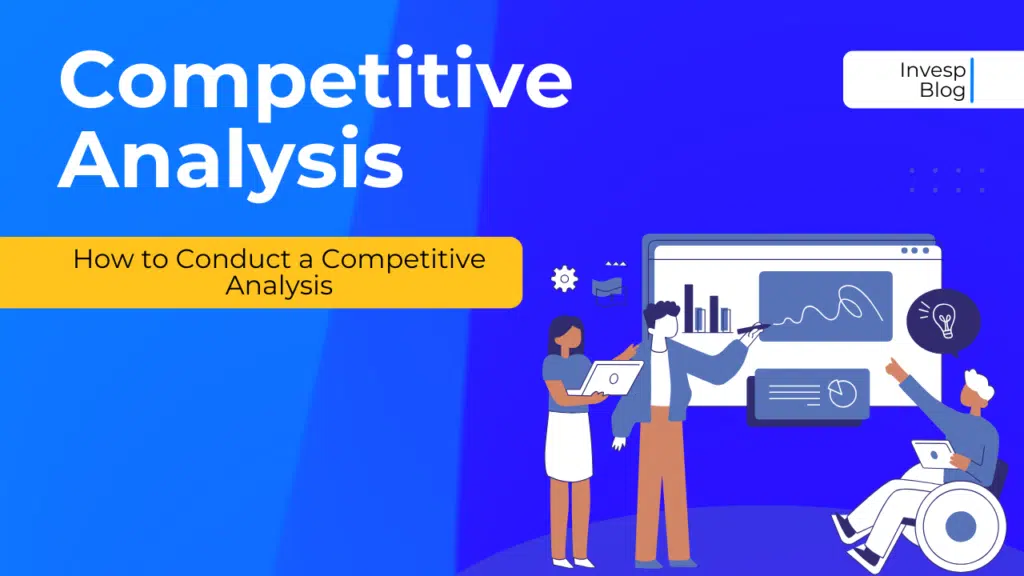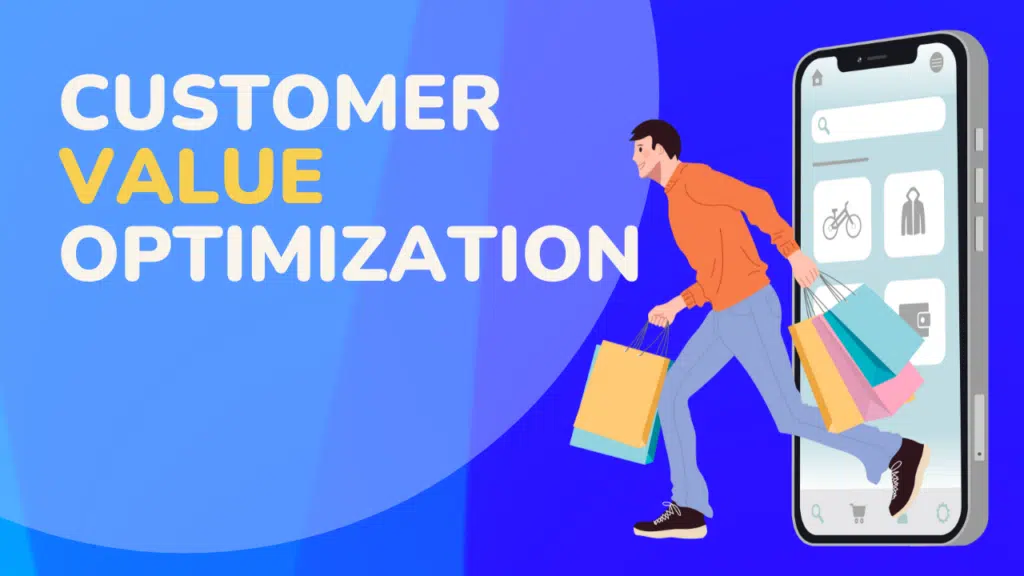Picture a customer who discovered your business, made a purchase, and left satisfied with their experience.
This customer represents a win, a step forward in your journey to business success. But your job doesn’t end here.
There are two scenarios: either that customer turns into a loyal brand advocate, or they turn to your competitor.
Retaining customers can be a bit like trying to hold onto a handful of sand. Without the right strategy in place, you’ll constantly be chasing new prospects and missing out on the incredible value loyal customers bring.
The effort, time, and resources you invest in customer acquisition can go down the drain if they don’t turn into returning buyers.
This is where Customer Retention Optimization becomes your lifeline.
With a customer retention strategy in place, your business can turn existing customers into loyal brand advocates. The result? A thriving business, a loyal customer base, and a strategy for long-term success.
Let’s see what it’s all about, how it works, and all the Customer Retention strategies you can use to keep hold of your customers.
Understanding Customer Retention Optimization
Customer retention optimization is a strategic approach to help you improve the retention of existing customers by enhancing overall experience and customer satisfaction.
If you want to stay ahead of the competition, you have to have a solid strategy in place to improve customer retention.
We talk a lot about acquiring and converting new customers through conversion rate optimization.
But retaining customers is equally, if not more, important.
Many studies over the years have revealed how retaining customers is more cost-effective than acquiring new ones. Some even discovered that acquiring a new customer can cost five to seven times more than retaining an existing one.
Aside from the low cost, customer retention optimization also leads to overall revenue growth, word of mouth, and referrals for your brand.
Existing loyal customers are also more likely to refer your product or services to other people, helping you acquire more customers. They’re also more likely to purchase from you more earnestly since they’re already familiar with your products or services.
But what are the factors that influence customer retention? How can you optimize the overall customer retention process to reduce customer churn and increase customer retention rates?
Let’s discuss some of the best tips and tricks to help you with your customer retention optimization goals:
Unlocking the Power of Customer Retention Optimization Strategies
Here are some of the best strategies to help you retain your current customers and build lasting relationships:
Provide excellent customer service
Don’t forget that your customers’ options are abundant. If you’re selling something, dozens of other businesses are probably selling the same thing.
One way to stand out and entice your customers is by providing excellent customer service.
A 60% of business leaders vouch that high-quality customer service is the golden ticket to improving customer retention. That’s not just a number; it’s a game-changer.
Let’s take Zappos, the online shoe and clothing brand, for example.
These guys have cracked the code when it comes to extraordinary customer service. They don’t just talk the talk; they walk the walk:
- 24/7 Customer Support: Zappos offers round-the-clock customer support, allowing customers to reach them at any time.
- No-Hassle Returns: Zappos has a famously liberal return policy, allowing customers to return items within a 365-day window, with free shipping both ways. This removes risk and stress for the customer.
- A Touch of Personal: After the advent of AI, it seems like you’re talking to robots left, right, and center. But when you talk to Zappos’ customer success team, you know right away you aren’t talking to robots. There’s a real person behind the screen – not just solving customers’ problems but also building connections.
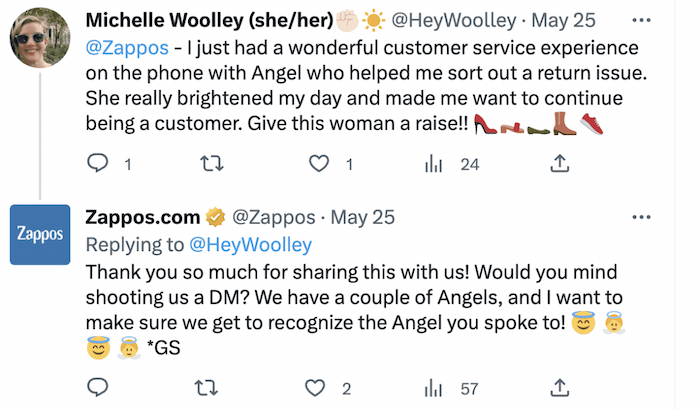
The Result?
While Zappos goes all out when it comes to providing excellent customer service, it does come to fruition.
According to a case study, 50% of Zappos’ customers come back for return purchases. That’s not a coincidence; it’s the result of customer service done right.
Not just that, a staggering 75% of Zappos’ total revenues come from those repeat customers.
In a nutshell, providing exceptional customer service is the surefire way to keep your customers coming back for more and turning them into your most loyal advocates for your brand.
Create tiered customer loyalty programs
When it comes to introducing loyalty programs, businesses usually implement rewards programs to reward their loyal customers with points or miles that they can redeem for goods or services.
This type of program has its benefits, but if you are trying to encourage brand advocacy, then you might want to consider creating a tiered customer loyalty program.
Tiered loyalty programs reward customers as they move up through different levels or tiers based on their loyalty and engagement with a brand. These programs encourage long-term customer commitment and spending while providing a sense of exclusivity and achievement.
For example, in the beginning, members may only receive basic offers from your organization.
As they earn more points, they will be able to access better offers as well as additional exclusive perks, including free shipping or discounts.
Here’s how tiered loyalty programs often work in practice:
- Multiple Tiers: These programs have several tiers – for example, Silver, Gold, Platinum, or similar designations. The rewards and benefits get better with each tier.
- Earn Points or Qualify: Customers can qualify for higher tiers by making purchases, referring friends, or any other pre-defined actions.
- Exclusive Rewards: As customers move up the tiers, they gain access to exclusive rewards. These rewards could be special discounts, free products, early access to sales, dedicated customer support, or even personalized experiences.
Aside from exclusivity, the gamified structure of the tiered loyalty programs also helps businesses engage customers through a gamified structure. The customers often find it exciting to reach the next tier or even maintain their current status, which also increases overall customer lifetime value.
Offer premium membership programs
Another great way to ensure your existing customers continue to purchase from you is by offering them a premium membership plan.
A premium membership plan gives customers access to special benefits and discounts – including free shipping and VIP treatment. You can get customers to pay a recurring subscription for the extra perks. The fee could be billed monthly or annually.
However, to entice customers to pay this recurring fee, your perks have to be substantial and solve real problems for them.
For one, members will gain access to exclusive benefits that are not available to regular customers. These benefits could be free shipping, early access to sales, personalized recommendations, dedicated customer support, or premium content.
Premium members often become part of an exclusive community. To elevate the sense of being a part of an exclusive community, you can also host members-only events, webinars, or forums to engage with your most dedicated customers.
Amazon Prime is a prime (pun intended) example of a successful premium membership program.
Here’s how Amazon made its Prime membership program a success:
- Subscription Fee: Members pay an annual fee (or a monthly fee in some regions) to access Amazon’s Prime membership. This fee then gives them access to exclusive benefits.
- Exclusive Benefits: One of the biggest reasons Amazon Prime is such a success is how Amazon caters to its members by offering the perks they want, including free two-day shipping on eligible items, access to Amazon Prime Video and Prime Music, early access to deals during Amazon Prime Day, and more. All these benefits enhance the overall Amazon shopping and entertainment experience in one way or another.
- Engagement: Amazon Prime also offers exclusive content and early access to Amazon Originals on Prime Video. This keeps members engaged with the platform and encourages them to continue their subscriptions.
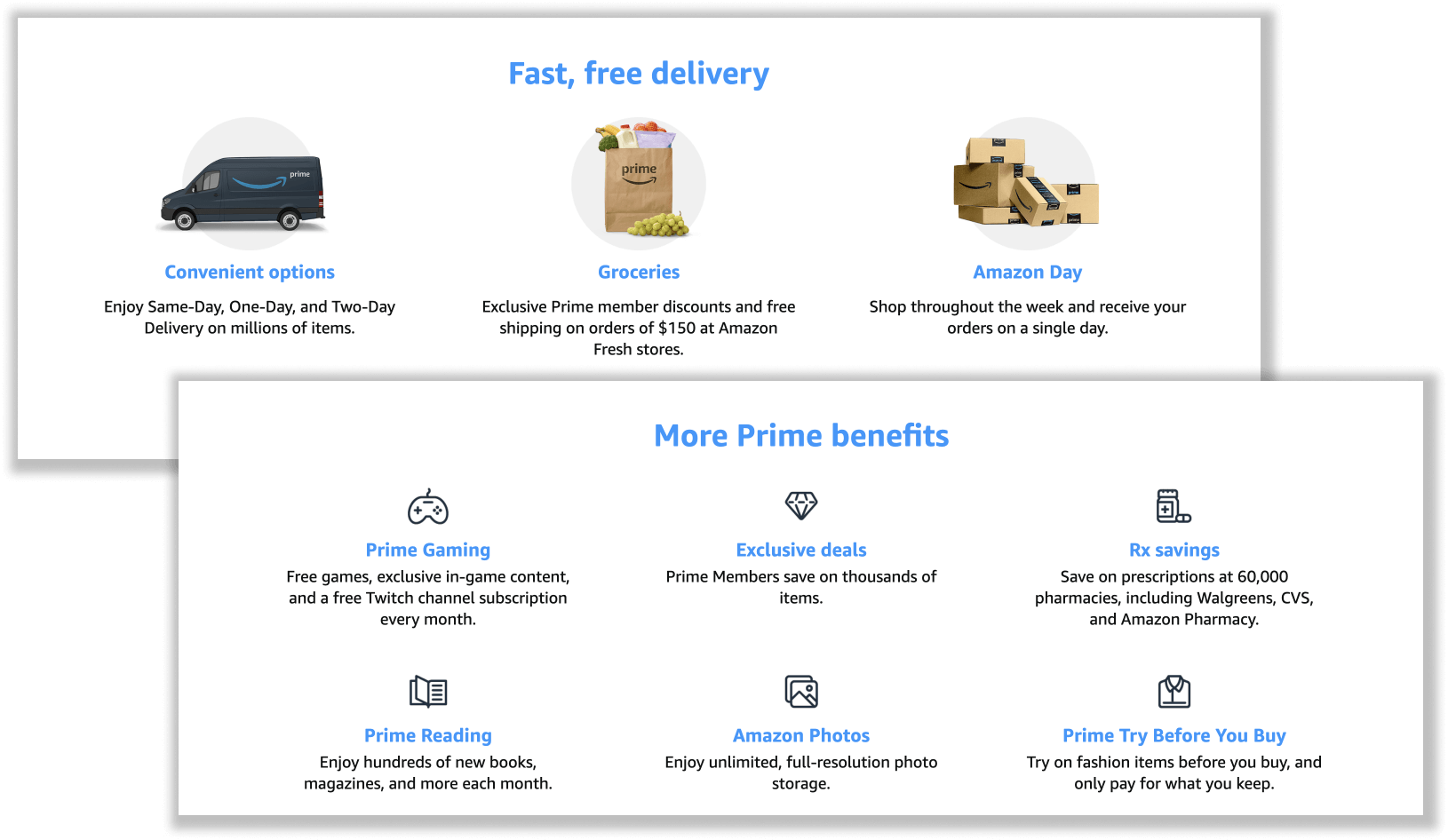
The result? Nearly 62% of all US households had subscribed to Amazon Prime as of Q1 2019.
Premium membership programs offer a win-win situation for both brands and customers.
You get to secure recurring revenue, higher customer retention rates, and a strong relationship with your customers – while customers enjoy exclusive benefits and a personalized experience.
Run personalized post-purchase email campaigns
Post-purchase email campaigns are vital for keeping customers engaged with your brand. This is especially true if you’re selling products or services that require ongoing use or support.
These campaigns involve sending tailored email messages to customers after they have made a purchase. They not only encourage you to purchase again, but they also help you build a deeper connection with customers and enhance their overall experience.
Here’s how personalized post-purchase email campaigns work:
- Data Collection: The first step is collecting data on your customer’s purchase behavior, browsing history, and preferences. This information will help you tailor the email to align with each individual’s preferences.
- Customer Segmentation: Once you’re privy to customer behavior, segment your email list based on this data. For example, you can group customers by similar purchase history, product category, or the like. It’s also easier to craft email content for different groups rather than each individual.
- Personalized Content: Craft tailored emails that reflect the specific customer’s journey. These emails can include order confirmations, product recommendations, post-purchase tips, and exclusive offers.
- Timing: Putting together a personalized email isn’t enough – you have to take the timing into account as well to maximize the impact. For example, you’ll want to consider sending an immediate order confirmation, a follow-up email after a few days, or a re-engagement email for customers who haven’t made a recent purchase.
For example, look at this post-purchase welcome message by Shopify:
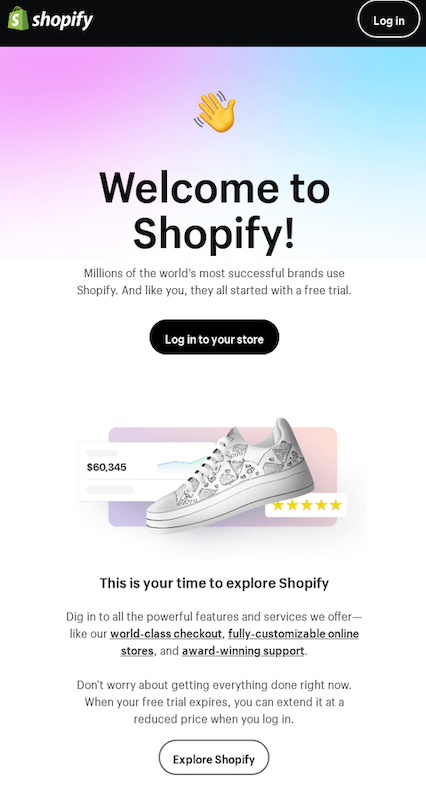
Shopify not only welcomes new customers but also shares important links and resources to help them get started. This creates a positive and personalized first impression.
Here are some tips to help you personalize your post-purchase email campaigns:
- Send a confirmation email within 24 hours of purchase.
- Use a follow-up sequence to highlight special offers and promotions, but only if relevant for each individual customer (e.g., free shipping).
- Send a reminder after a month or so to encourage customers to review their purchase experience.
- Collect customer feedback. Don’t just send out generic surveys – ask specific questions that will make the customer think about their purchase, like “How did this product compare to other options?” This helps build trust between the customer and your brand by showing that you care about what they think.
- Send personalized messages with product updates, product recalls, and new product announcements.
Multi-channel engagement
Gone are the days when you could acquire your customers, send an occasional email, and call it a day.
With your customers browsing the internet from multiple channels, you have to be there with them on each of those spots. You have to give them what they want, where they want it.
That’s what multi-channel engagement is all about.
A multi-channel engagement strategy involves using multiple platforms to communicate with your customers to meet them where they are most active. This means providing them with a seamless experience across all touchpoints and channels, including email, social media, or SMS.
Statistics also reflect the importance the important of multi-channel engagement.
As many as 57% of customers expect companies to reach out to them on every channel.
And when companies pay heed to this, it bears fruits as well.
If you look at the numbers, companies that use multichannel marketing see an 89% retention rate on average.
How can you adopt a multi-channel approach to engage and retain your customers? Here are some tips:
- Omnichannel Approach: Integrate omnichannel communication paths, including email, social media, SMS, phone calls, and in-app messaging, to create a seamless customer experience.
- Consistent Messaging: Regardless of the channel, make sure you’re consistently in touch with your customers. Don’t just forget them after a one-time purchase – keep them engaged with messaging that reflects your brand’s voice and values.
- Customer Preference: Allow customers to choose their preferred communication channel. Rather than trying every channel available, reach customers on their preferred medium.
- Integrated Data: Integrate customer data and interaction history across channels to make sure they receive personalized and context-aware communication.
Wrapping It Up: The Power of Customer Retention Optimization
This is it – these were some actionable customer retention strategies to help you exceed customer expectations and reduce customer churn rate.
With tens and hundreds of brands competing to catch the attention of the same customers, customer retention optimization is a vital part of your overall optimization strategy.
It involves a combination of personalized approaches, data-driven insights, and a commitment to delivering exceptional customer experiences.
By understanding the significance of retaining customers, implementing tailored strategies, and paying attention to customer behavior, businesses can achieve long-term success and build lasting customer relationships.
And that’s the essence of customer retention efforts. Not just keeping current customers or focusing on a stellar customer retention rate but also focusing on customer relationships and creating loyal brand advocates.

